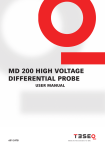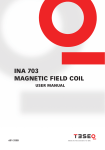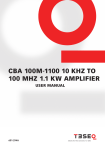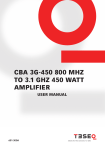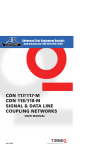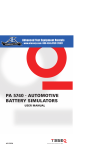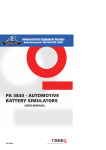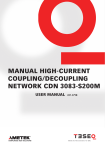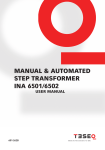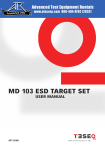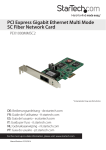Download 601-327A - NSG 5071 User Manual english.indd
Transcript
1 Nsg 5071 - inductive switch transient test circuit User Manual 601-327A Nsg 5071 - inductive switch transient test circuit User Manual NSG 5071 Inductive switch transient test circuit Contents 1 Explanation of the symbols used in this manual 2 Warning symbols on the test system 3 General safety 3.1 Overcurrent protection 3.2 Voltage protection 3.3 General warnings 4 Introduction to the NSG 5071 5 Installation of the NSG 5071 6 Usage of the NSG 5071 for CI 220 6.1 Battery input 6.2 CI 220 DUT output 6.3 Selecting the pulse 6.4 Controlling the input signal 7 Usage of CI 260 waveform F 8 Relay monitoring, usage and replacement 8.1 Resetting the counter 8.2 Replacing the relays 8.3 Relay usage 9Maintenance 9.1Cleaning 9.2Batteries 9.3Calibration 10 Example plots 11 Dimensions and weight 12 Specifications 13 Environmental conditions 14 Declaration of conformity 15Addresses 5 5 8 8 8 9 10 12 15 15 16 17 19 21 22 22 23 24 26 26 26 26 27 31 32 33 34 36 1 explanation of the symbols used in this manual Please take note of the following explanations of the symbols used in order to achieve the optimum benefit from this manual and to ensure safety during operation of the equipment. The following symbol draws your attention to a circumstance where failing to observe the warning could lead inconvenience or impairment in performance. Example: Please mind the polarity when connecting DUT cables. The following symbol draws your attention to a circumstance where failing to observe the warning could lead to component damage or danger to the operating personnel. Caution sign: A situation that may cause damage to the equipment. Example: Connect the system only to rated mains power. 5 6 Danger sign: Possibly dangerous situation that may cause damage to persons or heavy damage to the test equipment or DUT. Example: It is dangerous to fail to observe safety warnings. NSG 5071 Inductive switch transient test circuit 2 warning symbols on the test system This symbol is used on the test system to signify a dangerous condition if misused. Please read and understand the complete documentation of the NSG 5071 and the applicable standard references before putting the equipment into operation. 7 8 3 general safety The NSG 5071 system itself contains no dangerous voltages or currents, however, the application requires an external power source and can use up to 30 A for DUT power. Up to 30 A may be switched using the NSG 5071. Care should be taken in connecting and operating the DUT. 3.1 Overcurrent protection The NSG 5071 is designed using, and includes, the required Potter & Brumfield KUP-14A15-12 relay. The design can also (with the approval of Ford EMC) be used with other relays. It is important to limit the current in the application so as not to damage the relay that is installed, and in no case exceed 30 A, which is the maximum current limit of the NSG 5071. The user is responsible to limit the current of the battery voltage source to a level safe for the installed relay (10 A delivered). In case other relays are used, the current should be limited to a value of the installed relay, and not exceeding 30 A. 3.2 Voltage protection The NSG 5071 does not generate, on its own, dangerous voltages. However, it does contain inductances as part of the test setup that are switched to perform high voltage transient simulations. These transients may be high voltages caused by inductive kickbacks. Care should be used when powering the DUT through the NSG 5071 system. Refer to engineering or product documentation for your specific DUT. NSG 5071 Inductive switch transient test circuit Potentially dangerous voltage may be present at the cables leading to and from the DUT. Take care and follow all applicable safety guidelines given for your specific DUT. Operation of the NSG 5071 without the cover is dangerous and strictly forbidden. 3.3 General warnings DANGER! It is imperative that you read the following safety instructions and all safety instructions in the manuals of the connected peripheral systems before installing and starting this test system for the first time. DANGER! The electrical and mechanical safety equipment must not be removed, put out of operation or bypassed. Handle all safety equipment with care. If a safety device should be broken or is not working, the system must be put out of operation until the safety device is repaired or exchanged and fully in working order again. DANGER! HAZARDOUS AREA! Connectors on the test equipment should not be touched! The equipment may only be operated within an area that is explicitly declared a “Test Floor” (with appropriate signs) and protected against improper access. The operating instructions form an integral part of the equipment and must be available to the operating personnel at all times. All the safety instructions and advice notes are to be observed. 9 10 4Introduction to the nsg 5071 The NSG 5071 is designed exactly in accordance with EMC-CS-2009.1 (hereafter referred to as ‘the standard’) for test CI 220 pulses A1, A2-1, A2-2, C1, C2 and RI 130 using an inductive/relay transient generator test circuit (hereafter called ‘test circuit’). Because the same type of relay is used, CI 260 waveform F is included in this test circuit. This test circuit is defined in annex F for the A, C Pulses and RI 130 and figure 19-10 for CI 260 waveform F. The basic philosophy of this test circuit is better reproducibility of actual switching transients. The reproducibility of this test circuit comes not from the output characteristics as in traditional conducted automotive immunity tests, but from a fixed design of the generator using several pre-defined components. Many of these components are defined in the standard as “critical” with no substitutions allowed. Overview of the NSG 5071 NSG 5071 Inductive switch transient test circuit B Pulse C G BAT IN G L1 5uH SW1 A SW0 G FG IN NC E G Pulse A C BNC C D BNC C1 100 nF SW3 R2 220 Ω SW2 RLY 1 L2 100 mH R3 33 Ω R4 6 Ω Circuit Diagram NSG 5071 11 SW4 12 5Installation of the nsg 5071 For RI 220 pulses, the NSG 5071 must be placed on, and connected to the test bench earth using the convenient connections. The ARB signals must be provided as shown in the following diagrams and expanded in the following sections. Mode 1 ARB Mode 2 & 3 + - T DU To BATT Installation for CI 220 pulses NSG 5071 Inductive switch transient test circuit RI 130 contains a similar setup, but the output of the NSG 5071 is connected via two BNC cables to the parallel wire fixture. ARB To Clamp BATT + - Installation for RI 130 pulses For CI 220 and RI 130 pulses, the NSG 5071 must be connected to earth using the supplied earth connections. The earth connection of the NSG 5071 13 14 The installation for CI 260 waveform F is somewhat different. In waveform F, there are two signal sources that must be independantly controlled. These two signal sources both power the DUT and control the relay. For detials, see section 7. + Signal - Source 1 + Signal - Source 1 + - DUT Installation for CI 260 waveform F NSG 5071 Inductive switch transient test circuit 6 usage of the nsg 5071 for CI 220 6.1 Battery input The NSG 5071 is used per the guidelines in the standard. As seen in the circuit diagram, SW0 connects and disconnects the battery (| and О respectively) from the entire test circuit and DUT. As the circuit does nothing without battery, SW0 can be thought of as the power switch. The connectors labeled BAT IN are to be connected to the battery. While a power supply may be used, Ford specified a actual automotive battery during compliance testing and tests without an automotive battery are not considered compliant without specific permission from the standards writer. It is important to use only correct polarity! The negative BAT IN connector is, as defined in the standard, directly connected to chassis ground. The BAT IN connector and SW0 provides battery to the test circuit and DUT. The switching condition of RLY1 is dependant upon battery and the status of the FG IN voltage. The NPN transistor will pull activate the relay based on a positive TTL input signal. RLY1 is rated for 10 A. 15 16 Failure to observe proper polarity may result in damage to the DUT and NSG 5071! The supplied relay is exactly that specified in the standard. The standard recognizes the need for occasionally needing more battery current, and other relays may be used with written approval of Ford. In this case, the NSG 5071 has been specifically designed to accept up to 30 A of battery current. However, the supplied relay is specified for only 10 A. While the NSG 5071 can supply with up to 30 A, the supplied relay is specified 10 A max! For more information on exchanging the relays, please see the section 8. 6.2 CI 220 DUT output For all CI 220 testing, the DUT will be connected to either the pulse A or pulse C outputs. Pulse name A1 A2-1 A2-2 C-1 C-2 Output connector to use Pulse A Pulse A Pulse A Pulse C Pulse C NSG 5071 Inductive switch transient test circuit 17 The A1, A2-1 A2-2 DUT output The C1 and C-2 DUT output 6.3 Selecting the pulse Selecting the pulse is based on the switch positions of SW1 through SW4. Each pulse may be run in several modes, and some must be run in all three modes. Select the pulse using the handy reference printed on the front of the NSG 5071 and selecting the appropriate switch positions. 18 Pulse Mode SW1 SW2 SW3 SW4 A1 1, 2 Closed Closed Closed Closed A2-1 1 Closed Open Open Open A2-1, C-1 2 Closed Open Open Open A2-2, C-2 2 Closed Open Closed Open A2-1, C-1 3 Open Open Open Open A2-2, C-2 3 Open Open Closed Open The pulse selection table In all cases, the switch postioins is described below: During actual testing, it is a simple matter of choosing the correct switch positions and monitoring the DUT. For clarification, the purposes of the SW1 – SW4 are outlined below. SW1 – Switch 1 enables (open) or disabled (closed) the Mode 3 “self chattering relay” Mode. SW2 – Switches 220 Ohms in parallel with L2, effectively shaping the pulse shape. SW3 – Switches 100 nF capacitor in parallel with L2, effectively shaping the pulse shape. SW4 – Increases the impedance between L1 and earth. NSG 5071 Inductive switch transient test circuit 6.4 Controlling the input signal Once the NSG 5071 is connected to a battery voltage source, the relay can be driven with a standard TTL signal. The timings of the control signals can be found in the standard, but are shown below for reference. Mode 1 pulses are pulses that are triggered at fixed intervals. Mode 2 pulses are pulses that occur at defined, pseudorandom intervals. Mode 3 pulses use the same trigger signal as Mode 2 pulses, but the relay is self chattering during the trigger. Think of Mode 3 pulses as gated self-chattering events. The user must supply the TTL signals or use an NSG 5600 and the supplied cable. 19 NSG 5071 Inductive switch transient test circuit The Mode 2 and 3 control signal The Mode 1 control signal 20 7Usage of CI 260 waveform F Waveform F is a complex dropout test that depends on two controlled signal sources called “Signal Source 1” and “Signal Source 2” in the standard. As you can see in the following schematic, Signal Source 2 controls primarily the relay switching. When 12 V is supplied by Signal Source 2, the relay RLY2 will chatter. When Signal Source 2 is at 0 V, the DUT will be powered through Signal Source 1, which is also independently controlled. RLY 2 NC + + Signal Source 1 + Signal Source 2 - DUT - - T1 T1 T1 T1 T3 The control of CI 260 waveform F T4 21 22 8Relay monitoring, usage and recplacement The NSG 5071 is supplied with two Potter & Brumfield KUP-14A15-12 relays. Due to the extreme nature of the test, the relays performance may be degraded over time. Therefore, the relays are recommended by the standard to be replaced after 100 hours of operation. A counter is provided to determine how long the relays are used. Any time the relay is active, the counter will count. The NSG 5071 does not need to be actively switching at the time, but if the relay gets power, from BAT IN (CI 220) or Signal sSurce 1 is set to battery voltage (CI 260) the timer will run. This is, of course, the most conservative interpretation of “usage”, but represents a compromise to give the users of tracking the relay usage while at the same time having no effect on the pulses applied to the DUT. 8.1 Resetting the counter Each counter operates independently for RLY1 and RLY2 for CI 220/RI 130 and CI 260 respectively. Resetting the counter may be performed by pressing the red button on the counter. Resetting the counter NSG 5071 Inductive switch transient test circuit 8.2 Replacing the relays The relays may be replaced by loosening the five thumbscrews on the top of the NSG 5071 and carefully sliding the top cover to the rear. Take care not to damage the copper guide pins or the RF gasket. Everything should be disconnected to the NSG 5071 when exchanging relays. Loosening the thumbscrews Removing the cover Next, the relays can be removed by firmly grasping and lifting the relay and with a slight rocking motion. 23 24 Firmly grasping and lifting the relay Replacing the relay is a simple matter of pressing the relay into the supplied socket and closing the cover. Take care not to damage the copper guide pins and RF gasket. The copper guides and RF gasket 8.3 Relay usage The NSG 5071 contains two of the Potter & Brumfield KUP-14A15-12 that are specified in the standard. However, with the authorization of the standards writer, other relays may be used. For this reason, the NSG 5071 is designed for more current than the built-in relay can handle, and it provides connections for other relays. The convenient screen on the circuit board defines the various connections. Take care with the connections and the overall current limit of the system when using relays other than the KUP-14A15-12. NSG 5071 Inductive switch transient test circuit The user is responsible to limit the current of the battery voltage source to a level safe for the installed relay (10 A delivered). In case other relays are used, the current should be limited to a value of the installed relay, and not exceeding 30 A. The connections provided for other relays It is important to remove the KUP-14A15-12 before using any other type of relay. 25 26 9 Maintenance The only user replaceable parts are the relays RLY1 and RLY2. No other user serviceable parts are inside. The KUP-14A15-12 should be regularly checked. In some cases, it may wear out in much less than 100 hours. This is relay considered a consumable item in the NSG 5071. 9.1 Cleaning Clean only with a clean, dry cloth. No cleaners are recommended. 9.2 Batteries The clock has an internal, non-replaceable battery. This battery is rated for 10 years. Contact your Teseq representative for replacements. 9.3 Calibration No calibration is required. You should periodically check your NSG 5071 to ensure that the output can be compared to the example plots in the standard, and in this document. NSG 5071 Inductive switch transient test circuit 10 Example plots Your NSG 5071 should have plots that are representative of the plots seen here, and in the standard. Please note that these pulses are “pseudo-random” and every pulse will usually not appear exactly as shown. Additionally, it if often necessary to trigger on current – see the standard for more details. Pulse A1 27 28 Pulse A2-1 Detail Pulse A2-2 Contact break NSG 5071 Inductive switch transient test circuit 29 Pulse A2-2 Contact make and break Pulse C1 30 Pulse C2 CI 260 Waveform F NSG 5071 Inductive switch transient test circuit 11 Dimensions and weight Dimensions (LxWxH) Weight 353 x 270 x 126 mm (13.9 x 10.6 x 5 inch) 8.65 kg (19 lbs) 31 32 12 Specifications Maximum input voltage (Umax) Signal Source 1, Signal Source 2 BAT IN Maximum DUT current (Imax) Signal Source 1, Signal Source 2, BAT IN TTL control signal 15 V 10 A (Installed KUP-14A15-12 relay 30 A (Other relay) TTL low: 0-0.4 V TTL high: 2.63 - 5 V NSG 5071 Inductive switch transient test circuit 13 Environmental conditions Temperature range Operation at: Storage at: Humidity: Air pressure: +10 to +40º C -10 to +60º C 30 to 78% (non condensing) 860 to 1060 hPa 33 34 14 Declaration of conformity NSG 5071 Inductive switch transient test circuit NOTES 35 36 Headquarters Teseq AG 4542 Luterbach, Switzerland T + 41 32 681 40 40 F + 41 32 681 40 48 sales @ teseq.com www.teseq.com Manufacturer Teseq AG 4542 Luterbach, Switzerland T + 41 32 681 40 40 F + 41 32 681 40 48 sales @ teseq.com China Teseq Company Limited T + 86 10 8460 8080 F + 86 10 8460 8078 chinasales @ teseq.com France Teseq Sarl T + 33 1 39 47 42 21 F + 33 1 39 47 40 92 francesales @ teseq.com Germany Teseq GmbH T + 49 30 5659 8835 F + 49 30 5659 8834 desales @ teseq.com Japan Teseq K.K. T + 81 3 5725 9460 F + 81 3 5725 9461 japansales @t eseq.com Singapore Teseq Pte Ltd. T + 65 6846 2488 F + 65 6841 4282 singaporesales @ teseq.com Switzerland Teseq AG T + 41 32 681 40 50 F + 41 32 681 40 48 sales @ teseq.com Taiwan Teseq Ltd. T + 886 2 2917 8080 F + 886 2 2917 2626 taiwansales @ teseq.com UK Teseq Ltd. T + 44 845 074 0660 F + 44 845 074 0656 uksales @ teseq.com USA Teseq Inc. T + 1 732 417 0501 F + 1 732 417 0511 Toll free +1 888 417 0501 usasales @ teseq.com © December 2010 Teseq® Specifications subject to change without notice. Teseq® is an ISOregistered company. Its products are designed and manufactured under the strict quality and environmental requirements of the ISO 9001. This To find your local partner within document has been carefully checked. Teseq®’s global network, please go to However, Teseq® does not assume www.teseq.com any liability for errors or inaccuracies.




































